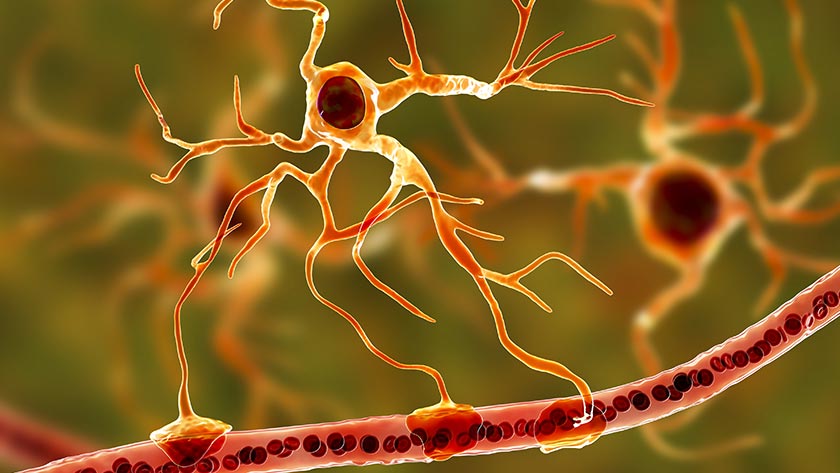The major signs and symptoms of Parkinson’s Disease (PD) – such as rigidity, resting tremor and bradykinesia – have long been attributed to the accumulation of abnormal proteins (Lewy bodies) in dopaminergic neurons in the brain’s basal ganglia. These eventually lead to the death of the neurons. The non-motor effects of PD – dementia, depression, sleep disorders etc – occur as damage spreads to other neurons.
But the actual causes of PD – what triggers the process that leads to the death of these neurons – are unknown. For many years, the focus of research was on the neurons themselves, but more and more, researchers are looking at the other cells in the brain for answers to the puzzle of neurological diseases.
While genetics plays a small role in the development of PD, age is the greatest risk factor. Environmental factors, including pesticides and toxins, also increase risk,1 but we do not understand why some people are more susceptible than others given the same risk exposure. And, while PD is unique among neurodegenerative diseases in having effective therapies for symptom control, there is no cure or therapies that delay its progression.2
Lewy bodies
Abnormal processing of the protein alpha-synuclein has been shown in the neurons affected by PD, leading to its accumulation (as Lewy bodies) and spread to other regions of the brain.2 Interestingly, the original sites of this abnormal protein activity are thought to be the olfactory bulbs and gut enteric nerves – the very earliest features of PD are anosmia and constipation.2 Lewy bodies contribute to, and/or may be caused by, mitochondrial dysfunction in affected cells. In turn, abnormal mitochondria increase oxidative stress in the cell, damaging structures and affecting function.
Oxidative damage and the presence of Lewy bodies trigger inflammatory responses in the brain that further damage the cells and may increase Lewy body formation. Thus, a cycle of abnormal alpha-synuclein, cellular damage and neuroinflammation is generated and spreads to critical regions of the brain.2
A team of researchers has now identified that similar processes may be occurring in some of the supporting (glial) cells of the brain. Astrocytes are the commonest cell type in the brain and were thought, until recently, to act only as supporting cells for neurons – ensuring a constant energy supply and maintaining the blood-brain barrier.3 But they also regulate synapse formation and elimination, and play key roles in regulating neuroinflammation and protecting against oxidative stress.3 Astrocytes also exchange mitochondria with neurons in response to cell damage or stress.4
Conventional thinking in PD states that astrocytes scavenge abnormal alpha-synuclein deposits as they develop in the neurons until they eventually become overwhelmed, at which time Lewy bodies start to form.4
However, a recent study has shown that astrocytes have increased production of alpha-synuclein in people affected by PD and that these cells are much more responsive to inflammatory triggers than non-PD astrocytes. The mitochondria of affected astrocytes are also abnormal.5 Thus, astrocytes show similar pathological changes in PD as the affected neurons and may present a target for future therapies.
References
- Pan-Montojo, F., & Reichmann, H. (2011). Considerations on the role of environmental toxins in idiopathic Parkinson’s disease pathophysiology. Translational Neurodegeneration, 3, 10. https://doi.org/10.1186/2047-9158-3-10
- Poewee, W., Seppi, K., Tanner, C., Halliday, G., Brundin, P., Volkmann, J., Schrag, A., & Long, A. (2017). Parkinson’s disease. Nature Reviews: Disease Primers, 3, 1-21.
- Siracusa, R., Fusco, R., & Cuzzocrea, S. (2019). Astrocytes: role and functions in brain pathologies. Frontiers in Pharmacology, 10, 1114. https://doi.org/10.3389/fphar.2019.01114
- Kim, Y., Park, J., & Choi, Y. (2019). The role of astrocytes in the central nervous system focused on BK Channel and Heme Oxygenase metabolites: a review. 8(5), 121.
- Sonninen, T., Hämäläinen, R., Koskuvi, M., Oksanen, M., Shakirzyanova, A., Wojciechowski, S., Puttonen, K., Naumenko, N., Goldsteins, G., Laham-Karam, N., Lehtonen, M., Tavi, P., Koistinaho, J., & Lehtonen, S. (2020). Metabolic alterations in Parkinson’s disease astrocytes. Scientific Reports, 10, 14474. https://doi.org/10.1038/s41598-020-71329-8




